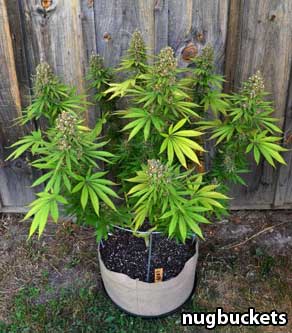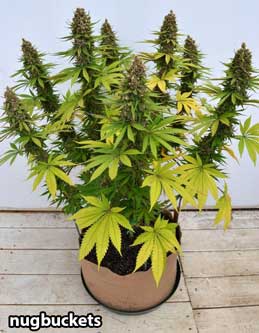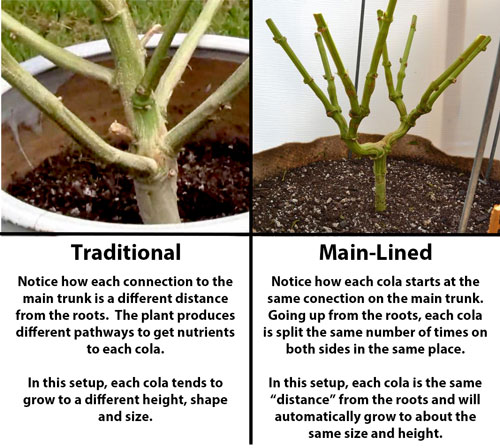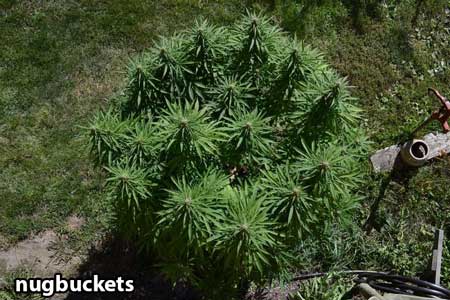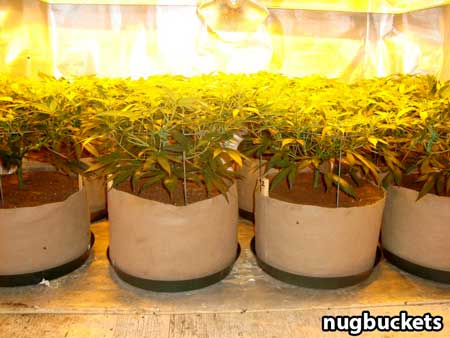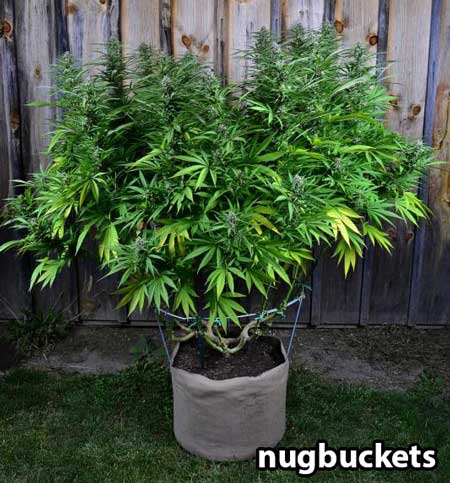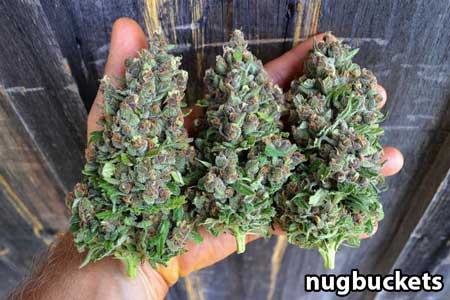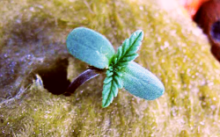You are here"Main-Lining" Tutorial by Nugbuckets: Train Marijuana Plants for Bigger Yields & Flat Canopies
"Main-Lining" Tutorial by Nugbuckets: Train Marijuana Plants for Bigger Yields & Flat Canopies
by Nugbuckets - Compiled and edited by Nebula Haze in August 2013
Read Nebula's Manifold Tutorial: http://www.growweedeasy.com/manifold
Table of Contents
-
Step-By-Step Tutorial - Main-Lining Technique
(starting from seed) -
Clone-Modified Main-Lining Tutorial
(starting from clone) -
Main-Lining Grow Journals - See Real Examples
"Main-Lining"
The act of training a cannabis plant to form a "hub" or "manifold" off a single node, creating a center for equal energy distribution from the roots to each cola.
See that main-lined marijuana plant at harvest.... Nothing but huge, dense buds!
Hub: A place or thing that forms the effective center of an activity, region, or network.
Manifold: A pipe or chamber branching into several openings, "the pipeline manifold"
The result of main-lining marijuana is an even canopy and bigger yields with little extra effort.
No more larfy popcorn buds stealing energy away from the main colas!
Here's a few more marijuana main-lining pictures so you can see what I mean about the effortlessly even canopy. Main-lining is effective for increasing yields both indoors and outdoors.
Outdoors - Greater stealth & control
Indoors - Easy flat canopies & bigger yields with the same grow lights
Forward by Nebula Haze: Nugbuckets is a talented marijuana grower and photographer who pioneered the term "main-lining" to describe his technique for marijuana training.
You can view his original set of posts about main-lining in their entirety here on Rollitup.org. You also don't want to miss his Nugbuckets' Lab thread where he posts additional pics and info about the main-lining technique as well as growing marijuana in organic soil.
In the original Nugbuckets main-lining threads, you must scroll through hundreds of pages to access all the information he generously put out there for the growing community. I have taken his work on main-lining marijuana and condensed it into one easy-to-navigate single-page article. Please note that Nugbuckets is the owner of ALL his photos!
I hope you enjoy this article and I encourage you to visit his original main-lining thread to offer your own support to Nugbuckets and let him know we are all interested in future growing information and pictures from him!
-
Bigger Yields - With the exact same setup
-
Set It and Forget It - After the initial training done during the very beginning of the plant's life, you don't need to do much else to get the benefits of main-lining
-
Effortless Canopy Management - Colas tend to naturally grow to the same height
-
Fatter Colas - Each cola grows to a similar size and weight, simplifying the drying/curing process and producing fat, even colas
-
No More Larfy Buds - No small, leafy "popcorn" buds to drain energy away from the main colas
-
No More Uncontrollable Stretching - Because energy is distributed evenly among all colas, main-lining reduces the undesirable "stretch" of just some colas when plants first switch to the flowering stage - this stretch often causes height/space problems for indoor growers
-
Indoors - More From Your Grow Lights - Get bigger yields from the same grow lights and setup
-
Outdoors - Increased Control and Stealth - Gain greater control over the dimensions of your final plant (for better stealth and reduced chance of mold) and produce a more desirable and consistent final product
Here is a picture of Nugbuckets showing off the fat, evenly shaped colas he produced from one plant using the main-lining technique
Main-Lining is just a concept about builing a plant off a single node. You don't have to get everything perfect to reap huge benefits. Many growers do main-lining their own way, and still get the rewards as long as they build their hub / manifold off a single node.
Main-Lining is an incredibly powerful way to gain complete control over your plants in small spaces, and also gives outdoor growers the power to control the size and shape of their plants for more consistent yields.
One of the best things about main-lining is that it's a "front-loaded" process. Most of the work happens right at the beginning of the plant's life, during the first few weeks. After that you mostly get to lay back and reap the benefits.
Set Up Your Hub / Manifold In the Early Vegetative Stage
(take a few weeks at most, when starting from seed)

Then just sit back and allow plants to grow into this naturally efficient shape

Bonus: The main-lining technique can be adapted to produce plants that fit in almost any space
As you're growing out young plants, simply pay attention to building thick stems from a single node on the trunk, (aim for a high VCSA - vascular cambium surface area) to evenly deliver nutrients from the roots to each of your colas.
That's it.
It doesn't matter how a grower achieves this. This tutorial and all the examples should get you started, and I encourage you to adapt this technique to suit your own setup and growing style.
Note: "Main-lining" is a name that was first coined by Nugbuckets. Nugbuckets says he is sure main-lining has been done before and it probably even has a name, but he just naturally started calling it main-lining and the name has stuck for growers around the world.
Main-lining is a form of plant training to help cannabis plants grow evenly, with only fat colas and no tiny "popcorn" buds that many growers just throw away.
These tiny buds take away energy from the big colas. Many growers choose to "lollipop" their plants by trimming away all the lower growth, yet main-lining takes lollipopping to a new level, with better results and less wasted energy.
What's the Difference Between Plain Lollipopping and Main-Lining?
With main-lining, you create a plant where every cola is exactly the same number of "steps" away from the roots. All colas originate from the exact same part of the marijuana plant, which naturally causes each cola to receive an even amount of nutrients and energy.
As a result, plants grow with an even, flat canopy, which produces the best yields for indoor growers using grow lights. Many different training techniques can be used to produce an even canopy, yet main-lining seems to be one of the most effective technique for small-scale marijuana growers.
With main-lining marijuana plants, the purpose is to build a "hub" off of a single node, creating a manifold for equal energy distribution from the root mass to the growing tops.
This pic shows what i mean by "manifold" really well.......my little V-8!
Notice how there is a main "hub" (manifold) to distribute energy evenly to all colas
First You Create A Hub So Each Cola Gets Equal Access to the Roots
With main-lining, all the branches/colas on a marijuana plant come off of the same node on the trunk. Each cola then gets an even amount of hormones and nutrients (growing supplies) from the root mass.
Basically you are building a "hub" from the roots, make sense?
This hub or "manifold" allows your plant to evenly distribute energy to all of the colas, so your canopy naturally grows flat, even and orderly.
All you have to do is follow the steps of creating a hub in the vegetative stage, and your young marijuana plants will naturally and automatically grow into this efficient shape, without much, if any, further work needed from you.
Therefore one of the big benefits of main-lining is it takes a lot of the hard work out of canopy management.
I am all about creating an even canopy of similarly sized stems and colas, like green lady soldiers lined up ready to kick ass and take names. No weak colas, no runts, no spindly branches. I love that with main-lining you pre-build your canopy so everything grows even and consistant.
Anyone who has grown indoors knows how hard it can be to produce an even canopy. Especially when you're growing in a small space, you've got to be able to keep your plant as short and wide as possible to take advantage of your indoor grow lights.
If you don't train your plants properly, it reduces your overall yields because some colas get bigger and taller than others, and then they block other bud sites from getting light.
With main-lining, you want all your colas to come off the main stem, like spokes on a wheel, so each of them is almost exactly the same as each other.
Take a look at this hub / manifold from a main-lined plant that had 16 main colas at harvest -
Notice how the growth is symmetrical on each side of the main split
This means that each cola gets to share nutrient pathways with all your other colas. This allows your plant to form just a small number of very efficient pathways, instead of spreading energy by making uneven pathways to many different nodes on the main trunk.
Main-lining is easy to accomplish when a marijuana plant is grown from seed since seedlings grow symmetrically. It's more difficult to main-line marijuana plants grown from clones since they usually do not grow symmetrically, but it's still possible.
I'll cover both methods in this article. Jump directly down to the...
How Nugbuckets Discovered Main-Lining
When I first started growing marijuana, I would top the main cola, and leave two nodes coming off the main trunk. This is structurally similar to what growers do when they FIM the plant. I'd begin to build my bonzai-type structure while trying to manage the canopy as well as I could.
Yet no matter what I tried, I still noticed a huge difference in the energy output of the colas originating from the upper and lower node, even when they were separated by mere inches on the trunk. They grew similarly, but colas still varied quite a bit.
Then it hit me, even a single inch on the trunk separating the two nodes was the key to these differences.
Even a single inch of space separating two nodes coming off a main trunk, like the plant in this picture below, will cause the colas to grow differently from each other
I wondered what would happen if I created a single manifold to distribute all the energy evenly from the main trunk.
In my next grow, I decided to build the entire structure off of a single node to create my manifold....
The results spoke for themselves... Creating a manifold off a single node caused the plants to naturally grow with more orderly canopies and long, dense colas. This technique also revealed a variety of other unexpected benefits.
Main-lining was born!
Disclaimer!!! Some strains are better suited than others for the main-lining method. The best strains for main-lining display "single cola dominance," which means that it tends to grow in the class "Christmas tree" shape of Indicas, Afghani strains, Kushes, etc.
Sativa dominant strains often do not grow in this shape, and tend to have lots of secondary branches naturally spring up. Clones also tend not display the same level of single cola dominance as plants grown directly from seeds. With that being said, main-lining can be used with all strains and even clones to optimize the nutrient distribution from the roots and create more balanced plants.
I've included several specific examples of main-lining below so you can see how the main-lining technique differs for different strains and growing styles.
Back up to the Main-Lining Table of Contents
Overview of the Basics:
How to Use The Original Main-Lining Technique
(Starting from Seed)
Table of Contents
-
Step 1: Wait until young marijuana plant has 5-6 total nodes
-
Step 2: Top plant down to 3rd node (Cut off stem and all the growth above the 3rd set of leaves)
-
Step 4: Repeat Step 3 until you have the total desired number of nodes
-
Step 5: Attach plant to tomatoe ring for easy control over all colas (optional)
-
Step 6: Once the plant shape and manifold are fully formed, remove any remaining clips or wires
-
Step 7: Sit back and let main-lining do the rest of the work for you!
What You Need To Start Main-Lining
-
Marijuana seedling
Where can I get seeds? - What if I'm starting from clone? -
Scissors or a razor to cut plant
-
A spool of Garden soft tie (which can easily be cut to the size you need) or some other soft bendy wire to bond/train plants
-
[Optional] Canopy ring / Peony Cage
The simple canopy rings I use are made from a heavy duty tomato or peony cage commonly found in garden stores. I cut and bend the bottom to spect. You should modify your canopy ring as needed for your setup.
When combined with soft ties, the hoop allows the grower to instantly modify the footprint of the plant simply by sliding the stems along the perimeter of the ring. This can come in very handy, when "puzzle piecing" plants into a defined space!
Nebula's Main-Lining Strain Pick: BlackJack


Why Did Nebula Pick Blackjack? This highly medical strain by Nirvana is easy to grow, responds like a champ to main-lining, and produces a Jack Herer / Haze style buzz
Step 1: Wait until marijuana plant has 5-6 total nodes
Learn how to germinate marijuana seeds
I believe the optimal time to start main-lining a healthy marijuana seedling is when she has 5-6 total nodes. Wait a little longer if you feel the plant is not growing fast and healthy.
Note: a node is a pair of growth tips that are directly across from each other.
Each growth tip has the ability to become a new main cola.

This BlackJack seedling is ready to start main-lining!
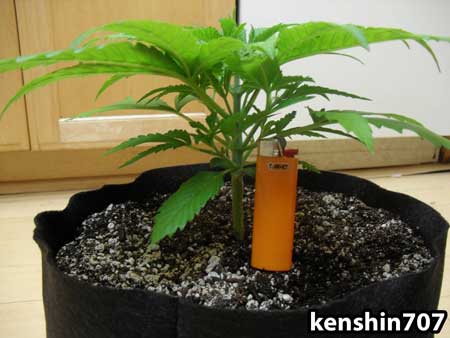
You can still use this technique if your plant is bigger and has already grown more nodes, but please note that this technique involves cutting off the top of your plant down to the 3rd node. So the bigger your plant is when you start main-lining, the more this technique will set you back, timewise.
So if you start with a bigger plant, you will be losing more of the time and effort your plants already put into their growth.
However, other than the time lost, there's no reason you can't start main-lining an older/bigger plant.
Just make sure the plant is still in the vegetative stage! Never start main-lining a plant that has already starting flowering (making buds).
You could start with a much bigger plant if you want - this older plant can still be main-lined
(you'll just lose the time spent growing past the 5th or 6th node)
In our experiments, we've found that main-lining when the plant has 5-6 nodes in total seems to get the best results with the least amount of extra vegetative time. With a plant this size, you get all the benefits of main-lining, without really adding much more time onto your grow.
I do not recommend cutting small plants with less than 5-6 total nodes. Especially young clones! (Note: This step-by-step tutorial is specifically for plants grown from seed, though you can jump down to the speficic process about main-lining clones) It is important that your plant has had time to establish a healthy root mass and be growing vigorously. When this technique is applied to younger plants, it tends to really slow down plant growth for quite a while.
Step 2: Top plant down to 3rd node (cut stem above 3rd set of leaves)
Cutting off the top of your plant is a technique known as "topping." So a common way you'll hear marijuana growers give these instructions is to say to "top your plant down to the 3rd node."
You can throw the top part of the plant away or you can replant this top and use it to create a new plant which is an exact copy (clone) of your original plant.
Learn more about using cuttings to produce new marijuana clones
After this step, your original plant should have just 3 nodes in total.
Step 2b: Remove all growth below the 3rd node
Remove all the growth, including cotyledons and fan leaves, below the 3rd node.
This third node will become the center of your main-lining manifold, and by removing all other growth, you are telling the plant to send all energy and effort to developing just that node.
Therefor the purpose of this step is to leave just the two stems/growth tips coming from the 3rd node, so that the roots only have to bring energy to this one hub / manifold. This will allow you plant to distribute energy evenly to all parts of the plant.
The 3rd node is going to become your manifold / hub, so with this step, you "tell" the plant to put energy only into the two growth tips on the 3rd node. Once the other growth tips are removed, the plant will divert all energy into the one node that's remaining.
Your plant should look something like this after this step
Or this...
Are you worried about taking off too much?
You may want to leave extra fan leaves on the plant for now, including the ones which are directly attached to the 3rd node.
What's most important in this step is removing extra growth tips below the 3rd node.
Leaving extra fan leaves is a big time-saving tactic, especially if your new main node hasn't grown out much, such as in this example below.

This plant was a bit too young to start being main-lined . She
definitely needed the extra power from a few extra fan leaves to
provide energy to the two tiny growth tips, so they grow out quickly.
With any plant, leaving a few extra fan leaves temporarily can help power the growth of nearby nodes.
Step 2c: Secure 2 new mains at right angles from the ground
Tie down your two new mains gently, so they form a right angle from the ground (or as close as you can).
If you waited until your 5th or 6th node to start-main-lining, you'll probably be able to do this step right away. However, if your 2 mains are too small to tied down, give your plant a couple of days so the new mains can grow out. Once you have enough growth on your mains to safely bend, it's time to start tis part of Step 2c.
Each strain grows differently in each setup. Some plants need extra time to grow out new mains. Other plants will already have long enough stems already that you can tie them down directly after the last step.
Some strains respond well to bending and training, others don't. Listen to your intuition. If you do happen to snap/break one of your stems, just tape it back up with duck tape and the plant may be able to heal herself.
I tend to really be a tad rough with my marijuana plants because I'm so familiar with how they grow, and I know when I'm pushing them too hard. If you're ever worried that you're moving too fast, then give plants a day or two between each step so you can see how they will react.
Slow, gentle movements will prevent injusty, while being one of the best ways to learn what your plants like and don't like.
In a stressful environment (such as very hot temperatures, if the plant is young, or if the plant is suffering from a problem/deficiency), it's always better to err on the side of waiting a little bit too long between steps, just to give your plant time to adjust and make sure she will be able to handle the bonding / pruning / training.
This is how Nugbuckets bonds his mains down - to the extreme with thick bendy wire
(these stems will turn back up towards the light in just a day or two)
Secure mains down without cutting into them. This is important!
You can use almost anything to tie down your plant, as long as it isn't thin enough to cut into the "skin" of the plant. Softt gardening wire, coat hangers, or anything relatively thick and bendy will do the job. Avoid string as it will cut into your plant!
This hydroponics plant was secured down with garden ties that were curved into hooks so they wouldn't directly cut into the plant - the other sides were hooked to the reservoir
Tying down your two mains coming out of the hub will keep your final plant much shorter overall, and this will give your main trunk the signature "main-lined" appearance.
Nugbuckets originally perfected main-lining in a 3' tall cabinet (pictures below), so every inch of vertical height was crucial. If growing indoors in a small space where lack of vertical space is an issue, definitely don't skip this step!
Quick Summary of Step 2
This one full plant in the middle shows the "before". The rest of the plants illustrate the "after" of what your plants should pretty much look like at the end of Step 2
Step 3: Allow plant to start growing vigorously again, then top all main colas symmetrically to double the number of mains
Watch the new colas (mains) you created in the last step.
Wait until plant has started growing fast and healthy. You will know it's time to take Step 3 when you notice your main colas are stretching upwards and growing heathfully.
Some growers wait for each main to grow out a few nodes, while other growers (including Nugbuckets) will often cut the plant after seeing just the growth tips fully formed.
These plants are green, healthy, and growing fast - they're ready to be topped again
Look along the length of your mains for nodes to become your new mains - nodes should be located in the same place on each side of the hub / manifold
On each main, choose a node. The nodes you choose will form the basis of new mains after topping the plant.
The most important aspect of this step is to make sure you choose nodes in the same place on both sides of the plant. This is very important to the efficiency of your hub / manifold.
Try to choose nodes that have symmetrical growth when possible, yet don't worry if you can't - main-lining will work as long as you choose nodes in the same place on both sides of the manifold.
Once you've chosen your nodes, top to that node (cut stem directly above the node).
Cut stems directly above your chosen nodes
Make sure you do this in the same place on every main, so every node you cut exactly matches one you're cutting on the other side of the manifold.
Be careful not to damage the growth tips coming out of the node as each one will soon become a new main.
For now, leave the fan leaves directly attached to the new mains. These will power their growth.
After
All your old mains should now look something like this - notice the two growth tips at the end, which will become new mains.
Each time you top all the mains on a plant, you will double the total number of main colas, so after this step, you will have twice as many mains as you had before.
Step 3b: Remove extra growth tips below your new mains
Nugbuckets will usually do this step directly after the last step. Some growers, especially beginner main-liners, may choose to wait a few days to make sure the plant has responded well to being topped, before removing the other growth tips. There's more room for error that way.
You can choose to leave or remove the fan leaves, Nugbuckets tends to remove all fan leaves except the ones directly attached to the remaining mains.
What is most important is that you remove all growth tips besides your new mains. You want your plant to be putting all her new growing energy into your chosen mains. Every other growth tip just steals energy away from the manifold you are creating.
Before
After
Step 4: Repeat Step 3 until you have the desired number of colas (keep topping plants until you have 8, 16, or 32 mains)
As Nugbuckets mentioned, each time you top the plant, it doubles the total number of colas. This is because you're essentially splitting a main cola in two with every topping.
So you top a plant once for 2 main colas, top a second time for 4 mains, top a third time for 8 mains, etc.
This chart should help you figure out how many times you want to top your plant in total, and how many colas will be produced. There's more information below the chart about why.

Growing Indoors: Top 3 times for 8 colas
As a general rule, when growing indoors under grow lights it's best to have 8 total nodes. This means you will top the plant a total of 3 times, including the first time.
Growing Outdoors or in Greenhouse: Top 3-4 or more times for 8-16+ colas
When growing outdoors it's best to have 8-16 total nodes or more to take advantage of the light of the sun and allow your plants to grow into huge bushy monsters. This means you will top the plant a total of 3-4+ times.
Growing Scrog Style: Top 5 times for 32 colas
When growing using the Scrog technique, I prefer to produce 32 total nodes to get the most out of each plant under the Scrog net. This means you will top the plant a total of 5 times.
I only use the Scrog technique when growing a Sativa dominant strain (as these tend to make lots more secondary branching and "fill out" more than Indica-dominant straains). I always allow the plant to have some time to stretch and really fill out under the net before I initiate flowering.
What does main-lining look like with a ScrOG setup?
Picture Example - Marijuana plant topped for 8 final mains
Before - 4 mains
Before - Side view
After
Same plant after being pruned for 8 mains (and secured to the sides of the pot)
Just a few days later, her 8 new mains are already pointed up and facing the sun
Picture Example - Plant topped for 16 mains
After waiting for the 8 mains to grow out a bit, you can prune / top again for 16 mains, like this plant
And so on, until you have the total desired number of mains.
Remember! More main colas is not necessarily better. For most setups, I've found that 8 or 16 main colas is the optimal number. Unless you're growing in a ScrOG setup, more mains usually won't result in bigger yields, but those plants do take longer in the vegetative stage.
Step 5: Attach plant to tomatoe ring for easy control over all colas (optional)
 You have done all the work of building your manifold, and now you are just guiding your plant into your desired shape.
You have done all the work of building your manifold, and now you are just guiding your plant into your desired shape.
Some growers choose to secure their mains in other ways, for example using gardening wire to attach colas to your growing pot / hydroponics reservoir, or installing a ScrOG net.
I personally prefer to attach the plant to a cheap and simple tomato ring, as this provides a great scaffolding.
These rings (sold as heavy duty tomato rings or peony rings) usually come much too tall, so I cut them down to spec.The exact size you want depends on your setup. I generally cut them so the hoop rests about 14" above the soil. You would want to go taller for bigger plants with more colas.
You will be able to secure your colas to the hoop as they grow (I use soft ties, so I can slide the colas around as I "piece the plant together."
Soft ties are a great way to secure mains to the ring
These tomato hoops will givs you an easy way to produce the flat, even canopy that most growers want.
If growing indoors where vertical height it limited, I will lightly supercrop plants to keep them ultra short and even, especially if I notice any colas growing taller than the rest.
You can either attach all your colas to the edges of the rings, or you can leave a few colas unattached so they take up the middle part. So for 8 colas, you would have 6 of the colas attached to the hoop, and 2 of the colas would be free to grow in the middle.
Step 6: Remove any clips or wires once the plant shape and manifold are fully formed
Remember that any clips or wires you use to hold down your plant are only for temporary bondage.
Pay attention to how tightly and how long they are wrapped around a specific branch or trunk.
Once the manifold and plant structure is formed, you can and should remove your bonds. If left on for too long, your wires can girdle and eventually damage / stunt the plant.
Step 7: You're pretty much finished! Now you mostly just sit back and let main-lining do the rest of the work for you
At this point, you're pretty much done!
Allow plants to continue to grow vegetatively until the tops of the mains have reaches about 6" above the top of the ring (or about 20" from the base of the roots). At this point, switch to the flowering stage and then you just let your plant do her thing!
Unlike most other forms of marijuana training, main-lining is a front-loaded process. Once you've reached Step 7, there's very little you need to do besides keep your plant alive and happy until it's time to harvest.
Learn the basics of caring for your marijuana plant
If you notice any mains getting taller than the others, you can gently slide that cola around the tomato ring until it's a more even height, or if you haven't used a tomato ring, simple pull that main out and away from the center of the plant and secure it down.
You can also use light supercropping to bend mains to an even height with your other colas while she's still in the vegetative stage.
Remember, you can use the soft ties and canopy ring to gently manipulate your plant as needed to fit into pretty much any sized space. I originally perfected this technique in a 3' tall cab!
Other than some light bending, your plant should naturally grow into a shape like this, producing huge, fat and dense colas that get the most out of your light!
Starting From Clone: Main-Lining Picture Tutorial by Nugbuckets
The main-lining clone tutorial has been moved to its own page for easy access.
View the full tutorial for main-lining clones by Nugbuckets
Starting From Seed: Nugbuckets Grow Journal - 8 Colas
This plant is from the strain "Ace of Spades" and was grown from seed.
I will build a foundation to support 8 fat, long and equal colas, coming from a central manifold, so none of the colas will be discriminated against by the roots.
I have already topped this marijuana seedling down to the third node. I removed the first node. You'll see that I left the 2nd node below the main hub for now. I am leaving these two growth tips so they can grow out and be cut off to produce 2 perfect clones.
If I wasn't saving the extra growth tips for clones, I would have removed all the growth below the 3rd node.
In the following picture, you can better see how the top node has been perfectly prepped to produce 4 new mains. Each side of the top node has two perfectly symmetrical growth tips.
After the extra node (the two growth tips on bottom) are removed to create clones, I will prune the rest of the plant so there's just the 4 mains, and adjoining fan leaves. Everything else is removed.
Now I will bond the 4 new mains down to the trunk.
It only takes a day or two before the seedling gets her stride back and those faces are turned up again.
This quick recovery is due to the fact that we allowed this seedling to grow out quite a bit initially, and build up a strong healthy root mass. Here's what she looks like from the top.
After the marijuana seedling recovers from her initial bonding and pruning, she is pruned a third time for 8.
Before - 4 mains
Side view - 4 mains
I choose a matching node on each of my 4 mains, and top / prune them so there are two matching growth tips left at the end of each one. I remove any other growth tips besides my chosen 8.
I remove the initial ties, and bond the 8 new mains down. This time I've bonded the mains to the sides of the pot.
You can bond to anything that is convenient, though it's usually easier to bond to the plant itself or the pot instead of something on the floor. This allows you to easily pick her up and move her around without messing up the bonding.
After
Closeup of bonds
(I use garden soft tie, which is thick bendy wire that can be cut to any size)
She quickly will turn all her new mains upwards, like little faces peaking up at the sun.
After just a few days, that same plant now looks like this.
After the plant has fully recovered, and appears to be growing fast and healthy, I transfer her into her bigger flowering pot. I use organic supersoil without added nutrients, so it's essential to transfer marijuana plants so they have enough nutrients in the soil to last all the way to harvest.
I add a canopy ring for future bending/training, and allow the young plant to veg for about two weeks.
You may choose to top all the nodes again for a total of 16 mains. Yep, you can go to 16, or even to 32 if you desire! Perhaps you may even go to 64, if it strikes your fancy, though I think 64 spreads the energy out too much unless you were doing some sort of serious ScrOG setup with a very long vegetative period.
Two weeks later...
The vegetative growth has reached the top of the hoop!
Sometime 1 or 2 mains will get a bit taller than the others. When this happens, some simple supercropping can come in handy. It's usually the center mains that do this, if any.
Now the plant is set up similar to a ScrOG setup. She has all these mains that are exactly as tall as the tomato ring, kinda like how you want all your mains to fill up the area below the ScrOG screen before you allow any of them to start growing above.
Unlike ScrOG, main-lining takes way less time. It should only take a few light pinch/bends to keep all your mains orderly if you've main-lined properly to this point. With ScrOG, you can spend hours grooming your plant and trying to keep everything even and under the ScrOG screen.
Now that everything is even at the tomato canopy ring, it's time to allow the mains to grow out 3-6 inches before the plant is put into the flowering stage, or allowed to enter flowering.
Allow mains to grow to 3-6" above the ring, or about 16"-20" above soil-line
Notice how I've trained 6 mains around the outside of the ring, with two mains in the middle
(you can see younger plants being main-lined on the sides)
Initiate Flowering
At this point, when your plant is 16-20" above the soil line, it is time to let her enter the flowering stage.
In the following pic, you can see our main Ace plant at the top, plus another Ace plant I main-lined which was topped an extra time for a total of 16 mains.
After about 2 weeks of receiving a flowering light schedule (at least 12 hours of dark each night), you'll notice that 50-75% of the flowering stretch is already complete.
Use Soft-Ties To Bond The Mains To Canopy Ring
At this point, the understory can be pruned (lollipopped) if you desire, and her giant "re-bar-like" stems can be softly tied to the ring as needed
Soft ties gently bond mains to the ring:
On an 8-headed plant, I usually leave 2 mains in the center and tie the other 6 around the edges of the perimeter.
I also have run all 8 mains around the outside. This can be a really great choice, especially for outdoor growers who suffer from mold, or growers who live in a high-humidity area. It really helps get air moving through all parts of the plant when the center is completely opened up, and this combats high humidity and susceptability to mold.
Here is the same plant after 3-4 weeks of flowering. At this point, I don't really have any work to do. I just allow the manifold to produce even, fat & incredible colas for me. Main-lining does all the work for you at this point!
....things are getting really exciting now!..... You can also see pics of the 16 headed main-lined Ace, which has been allowed to continue growing out vegetatively this whole time.
Harvest Time!!!!.......eight perfect donkey dicks!....not that a donkey's dick is perfect by any means.....you know what i mean!....
A question about how you main-lined these plants grown from seed...
Question: First off a huge thanks to Nugbuckets for sharing this with us. This is a fantastic walk thru of the main-lining method and I'd like to give it a try very soon.
However, after seeing this picture tutorial, I have a couple questions.
Do you begin by topping just above the second true node? You later remove the first nodes for clones leaving the second topped node as the working "main"? (To become the hub / manifold)
Then after some growth you top a second time and begin the bondage of the remaing four "mains"?
I've posted images below of your pictures with illustrations of what I'm asking. Am I on the right track?
Thanks for any answers!
Are these the 4 new mains?
Nugbuckets: where you have it marked "topped again" is the four mains...... one is hidden, but on the other side you can see the 2 growth tips coming out of the old main.
You can clearly see in the first pic that we are working the second and third true nodes on the trunk....the cody leaves are still attached, then the first true node (which was removed before any pictures were taken), then the clone node, then the hub.
Nugbuckets: Yeah bro, you got it..... Hope that clears things up for you!
....these mainlined Ace's went into their sun pots yesterday....they are pruned for 16, and have a good four weeks of heavy veg in front of them to build a good root mass, and fill out nicely....note....velcro did not work on these large tan smarties, so i went with the coated wire........just temporary until i get the mains soft-tied to the canopy ring....
I'm using coated wired to temporarily hold these girls in place, until they reach the canopy ring and I can use soft ties
Here's more pictures of that 16-headed main-lined Ace from before
...gallery of a different 16 headed main-lined Ace of Spaces....pheno #2
At harvest after being trimmed
Here's what those beautiful nugs look like up close!
A view of the manifold for that 16-headed girl
Harvest Weights - 8 Mains vs 16 Mains?
......so after all the bud is gone.....and there was a lot of it!......"8 heads" yielded 6.67 zips with zero larf on a 32 inch plant, "16 heads" yielded 7.31 zips with zero larf on a 27 inch plant!!!!......
........the main-lined plant still continues to give, and is a humble reminder of what can be accomplished when we quiet the noise in our heads enough to hear the secrets this plant unselfishly gives....much love and peace to all of you.......nugbuckets
Main-Lining Cabinet Tutorial Coming soon!
Continue below for additional questions and answers about main-lining by Nugbuckets!
"I really believe it is just a matter of time before a whole lot of growers world wide will be main-lining....it is a fucking game-changer!"
 ....I started growing in a closet. It was a 32" x 32" x 48" (tall). I was determined not to outgrow my space.....
....I started growing in a closet. It was a 32" x 32" x 48" (tall). I was determined not to outgrow my space.....
I would grow 4 plants in 3 gal. nursery pots under a single 400 watt HPS......I learned very quickly that if I wanted to end up with something smokable, I had to learn bonzai techniques in a hurry to manage my plant heights......
I started in with LST (low stress training), and managed a very, very modest harvest my first few attempts.......as each run progressed, I would find myself getting really anal about properly managing my 32" x32" canopy where i would jam up to 48 colas in my tiny space, and strive to make the canopy as flat as possible......
…...... i began to reap some pretty respectable harvests.......of course i would be topping the main, and spreading out the footprint of each plant, but my finished colas were not very consistant overall as far as size and weight were concerned.....and i would still end up with a fair amount of "larfy" popcorn bud from the understory, which was undesirable for me because i, and my newly found patients, were primarily flower smokers........so i dug deeper........and soon found myself in a slighty larger grow space, in a completely legal situation, allowing me to openly work on my developing theories.........
........my next grow i topped the main, and left two nodes off the main trunk, built my bonzai type structure, managed my canopy really well, but still noticed a huge difference in the energy output of the colas originating from the upper and lower node, even though they were separated by a mere inch on the trunk.....they were similar, but still varied quite a bit.......i did however end up with a decent canopy, and harvest.....i was getting closer......
.....then it hit me, that single inch on the trunk separating the two nodes was the key.....so my next grow, i decided to build the entire structure off of a single node....
....Main-Lining was born.....
Get Answers to Your Main-Lining Questions!
-
Could you tell me more about the difference between main-lining from seed and from clone?
-
More FAQs Coming Soon...
Why top the plants instead of FIM?
Question: With FIMing, you get 4 colas from one, instead of only 2 like with topping... It seems like it would be more efficient to just FIM the plants, right?
Answer by Nugbuckets
When you FIM the plant, you do get 4 main colas, but these come from 2 different nodes on the plant.
The point of main-lining is to get all colas to originate from ONE node, and FIMing can't accomplish this.
Even when the nodes are less than an inch away from each other, it seems to make a difference as far as how even the colas grow.
Result of FIM:
Result of Main-Lining:
Notice how in the main-lining example, all the colas originate from a single node on the trunk, like the trunk was split directly in two. This is the result of topping. This even split is one of the central principles of main-lining.
When you top the plant, you create 2 colas from 1 (you double the amount of colas), and each new cola will start at the same node. This is one the most important parts of main-lining; getting all the colas to originate off one node on the main trunk.
When you FIM the plant, you are still training your marijuana plants, and you may be making the energy distribution more efficient, but you are NOT main-lining.
I encourage growers to experiment and find out what works best for them. However, if you want to try main-lining, you must commit to topping your plants a few times, and you must avoid FIMing!
What is the difference between main-lining from seed or from clone?
Question: You say that main-lining is best done on seedlings which keep their symmetry, but could it be done on clones? I know the fact that the main arms are coming off of a central hub is nice, but will it work when they start alternating (as clones tend to do)?
The second question is, since you are doing it from seed, what happens if they happen to be males? I normally watch the nodes looking for sex, but this seems like it would make it hard. Are you waiting until flowering to see sex?
I plan on doing a trial run on some fems I'm gonna pop. Ones that I don't necessarily mind botching if I screw up, lol. Not that I don't trust you perse... Mainly because I don't trust me, lol. And I would hate to botch some seeds I care about because I'm a bonehead, lol.
Thanks again for sharing your invaluable information with us boneheads. MI power!
Answer by Nugbuckets:
It just makes things easier when the plant is symetrical, but it certainly can be done with clones.... check out the sub-tutorial i wrote about clones.........i force early sex when the little plants are about 8 inches tall, before pruning for 2.......
Followup question: When you say force early sex, you mean you will flip your seedlings to 12/12 and then flip them back to 18/6?
Nugbuckets: Pretty much. I just switch to 12/12 around day 21 from when seeds first sprouted, when they are about 8 inches tall... it takes about 5 days to weed out the males.....then i immediately top them, switch back to 20/4 and start my mainlining gig....
Can you use main-lining in a hydroponics setup?
Question: Is it possible to run this type of grow in 2 gal buckets in a hydroponic setup and still see considerable yields?
Answer by Nugbuckets:
i am not the guy to ask anything about hydro.....but main-lining has little to do with medium, it is a way to evenly distribute energy to the colas from the medium....will work with any medium.....hope that helps some, again, hydro just is not my field.....nugs
What does main-lining look like in a ScrOG Setup?
Answer by Nugbuckets:
Here's a 32 headed Vortex modular scrog/light dep/10 gal smartie/super soil...... She yielded over 10 ounces at harvest! She was just 23 inches tall from the soil line
Side view
How early can I start main-lining a young marijuana plant?
Question: Why can't I just top a young marijuana seedling right away and start main-lining from there?
Here's an example of a very young plant that I just started main-lining - what's wrong with starting this way?
Answer by Nugbuckets:
I know it can be tempting to get the ball rolling on the girls when they are really small, but experience is showing that if we wait a little longer for the root mass to build up a bit, the plants respond to pruning/training almost twice as fast.
The above ground growth can only thrive if it has enough root mass below it.
Also, be aware that the string you're using is too thin and might cut into your plant.
How much can I expect to yield per each plant with main-lining?
Answer by Nugbuckets:
This method is a killer......if done right, you should get anywhere from 3.5-5 ounces per plant, but as you know, there is a whole lot more that goes into a high yielding grow than mainlining alone....
i can say this.....if you had identical grows side by side, and one was mainlined...and this was the only variable...you would see a 50-100% increase in yield overall....
i went from yielding consistantly just over 20 zips in my space, to
pushing 40 every run.....(on average)......we just yielded 10.76 zips
on a single Vortex plant in a 10 gal. smartie...
How long do I wait until I top the first time? What type of timeframe should I be looking for?
Answer by Nugbuckets:
Just wait until your plant is about 8-10 inches tall, and has grown the sixth node or so.
As far as timeframes, it is hard to give a clear answer because every strain and setup produces plants that grow differently. That's the main reason why I haven't put together a day-by-day guide.
Some strains respond well to training, some hate it. Each unique strain and setup will produce plants that have varying degrees of vigor.
I've had growers send in pics who have successfully main-lined strains I didn't think would respond well to main-lining, such as tall, lanky equator Sativas or bagseed... and the pics show they still get amazing results!
Clones are another story because they really know their own personality as far as growth patterns are concerned. By the time you have a plant that is growing from clone, it has already developed "genetic memory" on how to grow. Plants from seed also have genetic memory, but their behavior can be worked with and altered to a certain degree. Think of it like "Teaching an old dog new tricks"....dig?
How long does main-lining take?
How much extra time does main-lining take compared to letting the plant grow naturally?
Answer by Nugbuckets:
There has been some confusion as to building a manifold, and how much time it takes, i have found that building a proper manifold only adds an average of 10-21 days on to the total veg cycle, but i average about 14 days......
the more you Main-Line, the more you will learn exactly when the plant is ready to be pruned and bonded....one must watch the plant very closely for her to tell you when she is ready to be pushed....
newbie growers don't really have this down yet, and it translates into added veg time.......also, clones take longer period.....
i highly recommend beginners starting out main-lining with a seedling, they are geneticly programmed to build a strong root mass out of the gate, (which is critical when it comes to how quickly the young plant will recover from pruning/bonding), as they are putting on early vegatative growth....a clone is a bit more tempermental.....
What's the Difference Between Lollipopping and Main-Lining?
Lollipopping A Marijuana Plant
Lollipopping means removing the lower growth of the plant that doesn't get good access to indoor grow lights. This lower growth would only produce "popcorn buds" if anything at all, but still uses a lot of resources from the plant.
I still use some amount of lollipopping (clearing extra larf from the bottom of the plant), but lollipopping is often used to make up for bad planning in the early stages of a plant's life.
Look at the picture below of a plant which was grown naturally then lollipopped:
Notice how much growth gets wasted when a plant grown naturally is lollipopped. This grower reports they let the plant get too big and then cut off nearly a 1.5 month's worth of growth from the bottom to try to make sure the plant would put that energy into producing dense buds on the colas closest to his indoor grow lights. That means 1.5 month's worth of electricity and money was wasted compared to if the grower had trained the plant properly from seed.
The removal of the lower growth allows the plant to put her energy into the top growth when producing buds (since the top is closer to the grow lights), but the plant still has the undesirable "Christmas Tree" shape that does not allows the entire plant to get good access to light. Only one or two colas will end up being fat and dense. The lower parts of the plant will produce tiny buds that many growers throw away.
Main-Lining Is Much More Effective Than Lollipopping For Producing Fat, Dense Colas In A Short Amount of Time
Set Up Your Hub / Manifold In the Early Vegetative Stage
(take a few weeks at most, when starting from seed)

Then just sit back and allow plants to naturally grow into this shape

More answers to your questions by Nugbuckets coming soon!
For Serious Growers Only
Main-lining isn't the only advanced technique available to growers...
You've told me you're looking for a complete guide to growing marijuana that covers everything, from beginner to ultra-advanced.
Learn from the best!
Invest in the most advanced Grow Bible Available: Growing Elite Marijuana by Ryan Riley
Total care explained step-by-step... indoors... outdoors...
Monster cropping... advanced growth control... bud production secrets... and much, much more...
Over 700 pages of pictures, tutorials and advanced insider tips!
Get Instant Access to It All Right Here: GrowWeedEasy.com/growing-elite-marijuana
I thought I already knew it all, but after I went through this grow bible, I discovered that there were still lots of easy ways I could increase my yields and grow even more potent buds! I find myself going back to it again and again for new ideas.
-Nebula


